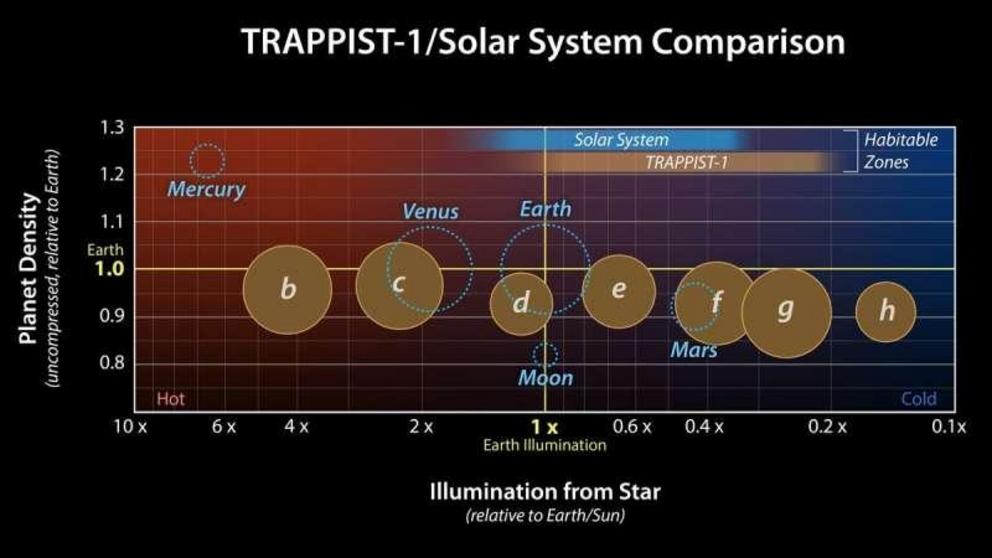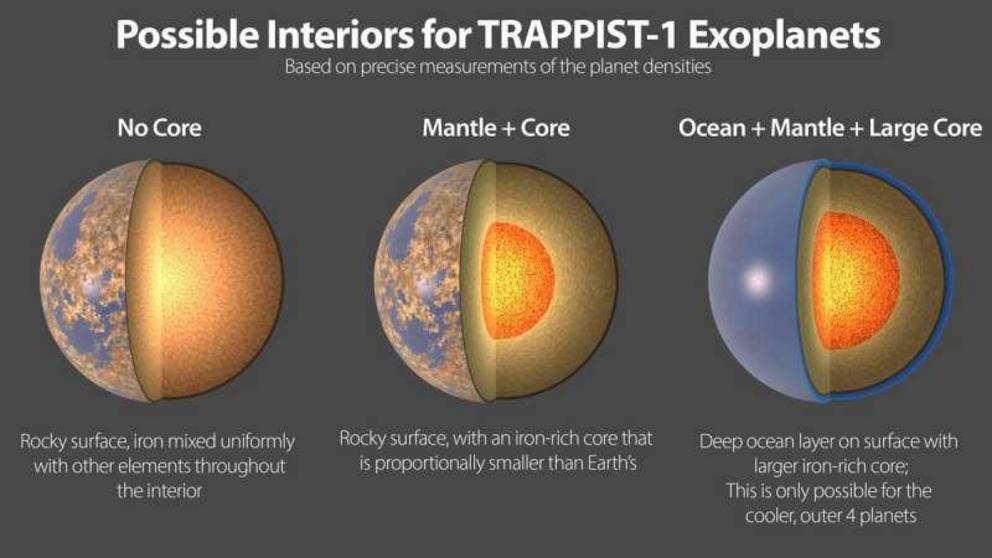The seven rocky planets of TRAPPIST-1 seem to have very similar compositions
This illustration shows three possible interiors of the seven rocky exoplanets in the TRAPPIST-1 system, based on precision measurements of the planet densities. Overall the TRAPPIST-1 worlds have remarkably similar densities, which suggests they may share the same ratio of common planet-forming elements. The planet densities are slightly lower than that of Earth or Venus, which could mean they contain fractionally less iron (a highly dense material), or more low-density materials, such as water or oxygen.In the first model (left), the interior of the planet is composed of iron mixed with lighter elements, such as oxygen. There is no solid iron core, as is the case with Earth and the other rocky planets in our own solar system. The second model shows an overall composition similar to Earth, in which the densest materials have settled to the center of the planet, forming an iron-rich core proportionally smaller than Earth's core.A variation is shown in the third panel where a larger, denser core could be balanced by an extensive low density ocean on the planet's surface. However, this scenario can only be applied to the outer four planets in the TRAPPIST-1 system. On the inner three planets, any oceans would vaporize due to the higher temperatures near their star, and a different composition model is required. Since all seven planets have remarkably similar densities, it is more likely that all the planets share a similar bulk composition, making this fourth scenario unlikely, but not ruled out. The high precision mass and diameter measurements of the exoplanets in the TRAPPIST-1 system have allowed astronomers to calculate the overall densities of these worlds to an unprecedented degree of accuracy in exoplanet research. Density measurements are a critical first step in determining the composition and structure of exoplanets, but they must be interpreted through the lens of scientific models of planetary structure. Credit: NASA/JPL-Caltech
The red dwarf star TRAPPIST-1 is home to the largest group of roughly Earth-size planets ever found in a single stellar system. Located about 40 light-years away, these seven rocky siblings provide an example of the tremendous variety of planetary systems that likely fill the universe.
A new study published today in the Planetary Science Journal shows that the TRAPPIST-1 planets have remarkably similar densities. That could mean they all contain about the same ratio of materials thought to compose most rocky planets, like iron, oxygen, magnesium, and silicon. But if this is the case, that ratio must be notably different than Earth's: The TRAPPIST-1 planets are about 8% less dense than they would be if they had the same makeup as our home planet. Based on that conclusion, the paper authors hypothesized a few different mixtures of ingredients could give the TRAPPIST-1 planets the measured density.
Some of these planets have been known since 2016, when scientists announced that they'd found three planets around the TRAPPIST-1 star using the Transiting Planets and Planetesimals Small Telescope (TRAPPIST) in Chile. Subsequent observations by NASA's now-retired Spitzer Space Telescope, in collaboration with ground-based telescopes, confirmed two of the original planets and discovered five more. Managed by NASA's Jet Propulsion Laboratory in Southern California, Spitzer observed the system for over 1,000 hours before being decommissioned in January 2020. NASA's Hubble and now-retired Kepler space telescopes have also studied the system.
All seven TRAPPIST-1 planets, which are so close to their star that they would fit within the orbit of Mercury, were found via the transit method: Scientists can't see the planets directly (they're too small and faint relative to the star), so they look for dips in the star's brightness created when the planets cross in front of it.

This graph presents measured properties of the seven TRAPPIST-1 exoplanets (labeled b through h), showing how they stack up to each other as well as to Earth and the other inner rocky worlds in our own solar system. The relative sizes of the planets are indicated by the circles. All of the known TRAPPIST-1 planets are larger than Mars, with 5 of them within 15% of the diameter of the Earth.The corresponding "habitable zones" of the two planetary systems, regions where an Earth-like planet could potentially support liquid water on its surface, are indicated near the top of the plot. The offset between the two zones is due to the cooler TRAPPIST-1 star emitting more of its light in the form of infrared radiation that is more efficiently absorbed by an Earth-like atmosphere. Since it takes less illumination to reach the same temperatures, the habitable zone shifts further away from the star. The masses and densities of the TRAPPIST-1 planets were determined by careful measurements of slight variations in the timings of their orbits using extensive observations made by NASAs Spitzer and Kepler space telescopes, in combination with data from Hubble and a number of ground-based telescopes. The latest analysis, which includes Spitzer's complete record of over 1,000 hours of TRAPPIST-1 observations, has reduced the uncertainties of the mass measurements to a mere 2-3%. These are by far the most accurate measurements of planetary masses anywhere outside of our solar system. Credit: NASA/JPL-Caltech
Repeated observations of the starlight dips combined with measurements of the timing of the planets' orbits enabled astronomers to estimate the planets' masses and diameters, which were in turn used to calculate their densities. Previous calculations determined that the planets are roughly the size and mass of Earth and thus must also be rocky, or terrestrial—as opposed to gas-dominated, like Jupiter and Saturn. The new paper offers the most precise density measurements yet for any group of exoplanets—planets beyond our solar system.
Iron's Reign
The more precisely scientists know a planet's density, the more limits they can place on its composition. Consider that a paperweight might be about the same size as a baseball yet is usually much heavier. Together, width and weight reveal each object's density, and from there it is possible to infer that the baseball is made of something lighter (string and leather) and the paperweight is made of something heavier (usually glass or metal).
The densities of the eight planets in our own solar system vary widely. The puffy, gas-dominated giants—Jupiter, Saturn, Uranus, and Neptune—are larger but much less dense than the four terrestrial worlds because they're composed mostly of lighter elements like hydrogen and helium. Even the four terrestrial worlds show some variety in their densities, which are determined by both a planet's composition and compression due to the gravity of the planet itself. By subtracting the effect of gravity, scientists can calculate what's known as a planet's uncompressed density and potentially learn more about a planet's composition.
The seven TRAPPIST-1 planets possess similar densities—the values differ by no more than 3%. This makes the system quite different from our own. The difference in density between the TRAPPIST-1 planets and Earth and Venus may seem small—about 8% – but it is significant on a planetary scale. For example, one way to explain why the TRAPPIST-1 planets are less dense is that they have a similar composition to Earth, but with a lower percentage of iron—about 21% compared to Earth's 32%, according to the study.
Alternatively, the iron in the TRAPPIST-1 planets might be infused with high levels of oxygen, forming iron oxide, or rust. The additional oxygen would decrease the planets' densities. The surface of Mars gets its red tint from iron oxide, but like its three terrestrial siblings, it has a core composed of non-oxidized iron. By contrast, if the lower density of the TRAPPIST-1 planets were caused entirely by oxidized iron, the planets would have to be rusty throughout and could not have solid iron cores.
Eric Agol, an astrophysicist at the University of Washington and lead author of the new study, said the answer might be a combination of the two scenarios—less iron overall and some oxidized iron.
The team also looked into whether the surface of each planet could be covered with water, which is even lighter than rust and which would change the planet's overall density. If that were the case, water would have to account for about 5% of the total mass of the outer four planets. By comparison, water makes up less than one-tenth of 1% of Earth's total mass.
Because they're positioned too close to their star for water to remain a liquid under most circumstances, the three inner TRAPPIST-1 planets would require hot, dense atmospheres like Venus', such that water could remain bound to the planet as steam. But Agol says this explanation seems less likely because it would be a coincidence for all seven planets to have just enough water present to have such similar densities.
"The night sky is full of planets, and it's only been within the last 30 years that we've been able to start unraveling their mysteries," said Caroline Dorn, an astrophysicist at the University of Zurich and a co-author of the paper. "The TRAPPIST-1 system is fascinating because around this one star we can learn about the diversity of rocky planets within a single system. And we can actually learn more about a planet by studying its neighbors as well, so this system is perfect for that."
More information: Planetary Science Journal, DOI: 10.3847/PSJ/abd022, https://iopscience.iop.org/article/10.3847/PSJ/abd022
Provided by NASA

